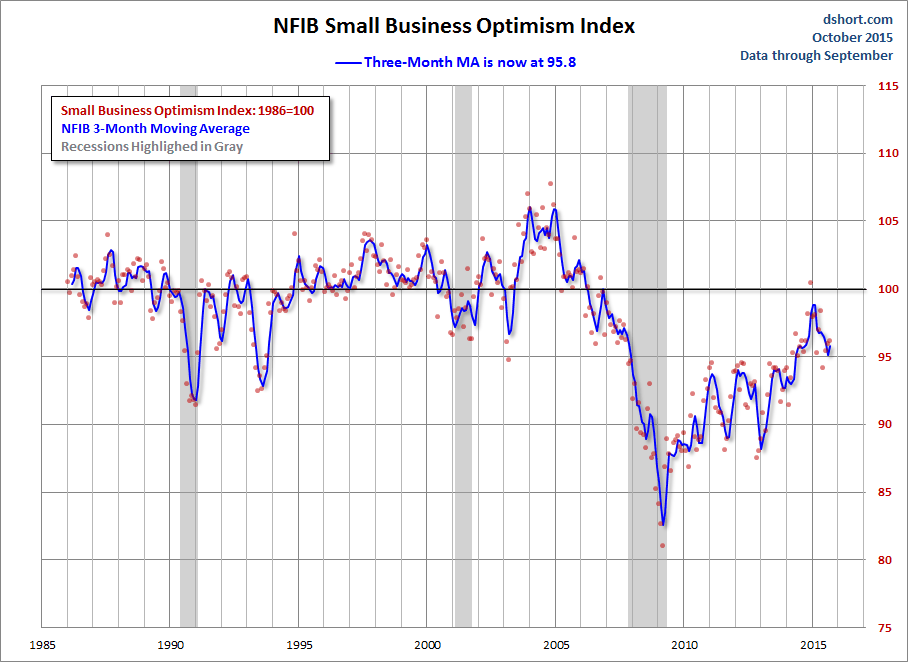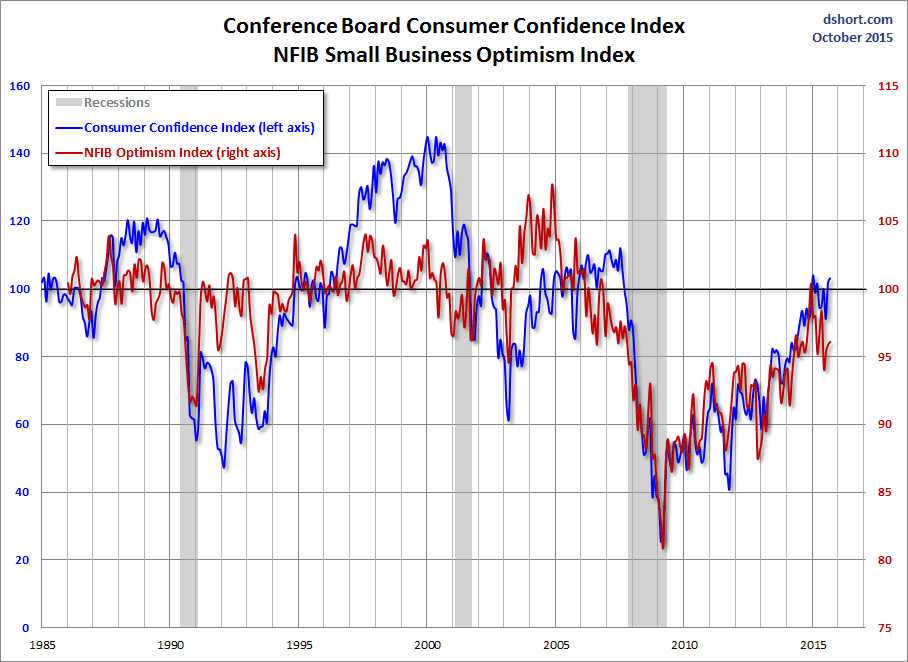The latest issue of the NFIB Small Business Economic Trends was out yesterday. The update for September came in at 96.1, only a 0.2 point increase from the previous month. The index remains at the 29th percentile in this series.
Nevertheless, today's number came in above the Investing.com forecast for a 0.3 point decline to 95.6.
Here is the opening summary of the news release.
"Small business optimism continues to be stagnant, which is consistent with the expected economic growth of about 2.5 percent. The percent of owners citing the difficulty of finding qualified workers as their Most Important Business Problem increased and is now third on the list behind taxes and regulations. This is the highest reading since 2007 and suggests that employers will continue to face wage pressure in order to attract and keep good employees." — Bill Dunkelberg, NFIB Chief Economist
The first chart below highlights the 1986 baseline level of 100 and includes some labels to help us visualize that dramatic change in small-business sentiment that accompanied the Great Financial Crisis. Compare, for example the relative resilience of the index during the 2000-2003 collapse of the Tech Bubble with the far weaker readings following the Great Recession that ended in June 2009.
The average monthly change in this indicator is 1.3 points. To smooth out the noise of volatility, here is a 3-month moving average of the Optimism Index along with the monthly values, shown as dots.
Here are some excerpts from the report.
Labor Markets
Overall, a solid improvement in hiring activity. There was no evidence in the NFIB data that job creation slacked off sharply from June and July, each with 245,000 jobs. Reported job creation returned to its best level of the year, with owners adding a net 0.18 workers per firm in recent months, up 0.05 from August.
Credit Markets
Has the Fed's zero interest rate policy and quantitative easing had a positive impact on Small Businesses?
Two percent of owners reported that all their borrowing needs were not satisfied, a record low. Thirty percent reported all credit needs met, and 57 percent, a record high, explicitly said they did not want a loan. Twenty-nine percent of all owners reported borrowing on a regular basis, down 4 points.
NFIB Commentary
This month's "Commentary" section includes the following observations:
The Federal Reserve decided that doing nothing was the best thing for jobs – or for “global concerns” or to make LeGarde and the World Bank happy along with all of the equity traders even though the evidence suggests that the Fed can’t impact employment significantly. None-the-less, Chairman Yellen put “jobs” at the top of her policy priority list. Meanwhile, banks can only lend to the best borrowers at the Fed’s low rate structure, believing that the cost of funds will rise and squeeze out profitability before rates can be reset. Savers aren’t interested in lending their money (depositing at banks, etc.) at these low rates. Trillions of dollars of low yield Treasury securities issued over the past 7 years guarantee sub-par returns to savers and investors for the next decade. Interest income is billions below what “normal” rates would deliver and the Fed continues to hoard trillions of dollars in riskless securities that the market would love to have. Cheap money induces investors to make investments that wouldn’t pass muster in a normal economy. Not a helpful set of outcomes.
Business Optimism and Consumer Confidence
The next chart is an overlay of the Business Optimism Index and the Conference Board Consumer Confidence Index. The consumer measure is the more volatile of the two, so it is plotted on a separate axis to give a better comparison of the volatility from the common baseline of 100.
These two measures of mood have been highly correlated since the early days of the Great Recession.
Which stock should you buy in your very next trade?
With valuations skyrocketing in 2024, many investors are uneasy putting more money into stocks. Unsure where to invest next? Get access to our proven portfolios and discover high-potential opportunities.
In 2024 alone, ProPicks AI identified 2 stocks that surged over 150%, 4 additional stocks that leaped over 30%, and 3 more that climbed over 25%. That's an impressive track record.
With portfolios tailored for Dow stocks, S&P stocks, Tech stocks, and Mid Cap stocks, you can explore various wealth-building strategies.



